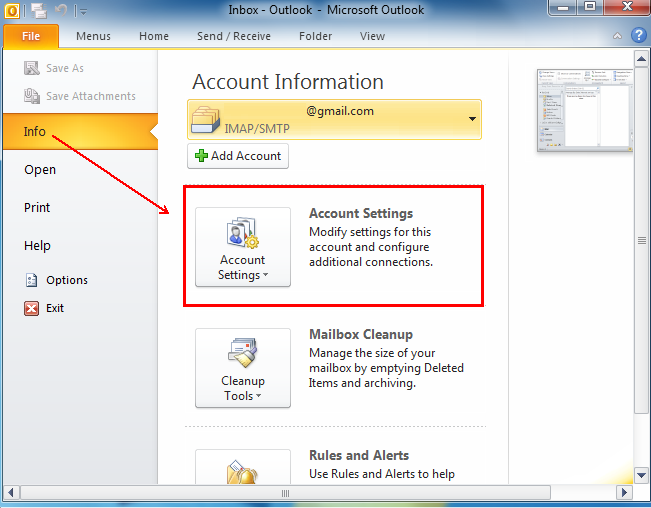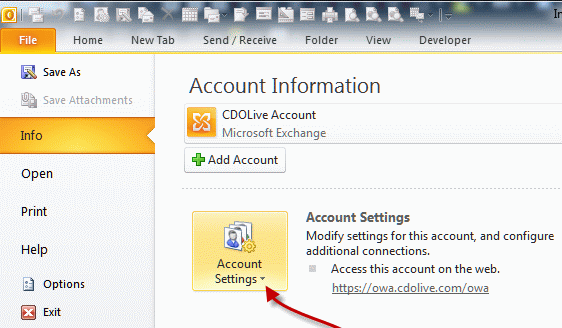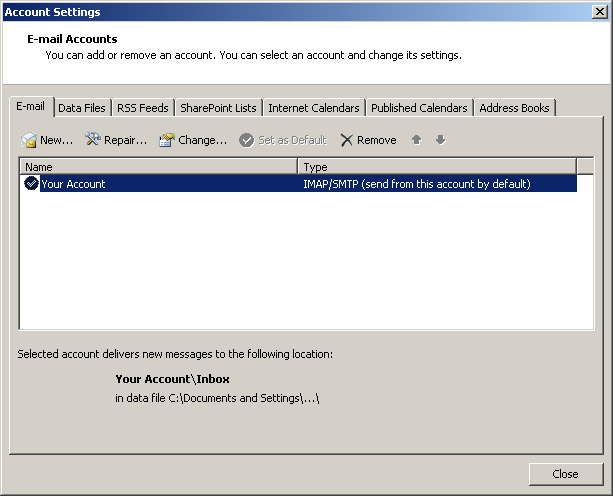

- #Where is account settings for outlook 2010 generator#
- #Where is account settings for outlook 2010 password#
You should always use NTLM over Basic authentication as Basic sends the username and password in the clear, and NTLM doesn't as it is Windows Authentication. All InternalUrl and ExternalUrl's should be setup using the hostname (assuming is the OWA URL that you chose). It actually causes more problems than it fixes, so where possible, you should log into your domain's external DNS Manager and remove the wildcard record.Īfter Split-DNS is confirmed working, the next things to check and fix are the Virtual Directories and the Client Access Server Autodiscover URI. Some webhosting companies do this for subdomain management instead of putting an explicit hostname in their DNS records. If it does resolve to an IP, there is likely a wildcard record on your domain (*.) that is pointing to your webserver.
#Where is account settings for outlook 2010 generator#
You should use an SPF Generator to get the proper syntax for your SPF Record ( ).Īnd the 7th nslookup command should respond that this record does NOT EXIST. If your domain does not have an SPF record, some recipient domains may reject messages from your users because they cannot validate that the messages come from an authorized mail server. The purpose of an SPF record is to prevent spammers from sending messages with forged From addresses at your domain. A Sender Policy Framework (SPF) record identifies which mail servers are permitted to send email on behalf of your domain. The 6th nslookup command will show you your TXT records - these records are used for extra information in DNS, and one of the extra pieces of information you should have in there is an SPF record. In the case of an onsite appliance, create a new A record called and give it the IP for your Anti-Spam Appliance, and then set the MX Records to 10. If you are directing inbound mail traffic to an Anti-Spam 3rd party provider, this will be the hostname(s) associated with them. They should have a priority at the beginning where the lowest number is the preference. MX Records should NOT point to an IP Address as stated in RFC1035 ( ).

The 5th nslookup command will show you your MX records on the internet. To fix the external records (more than likely, autodiscover is the one that doesn't exist and needs to be created), on your domain's external DNS Manager create an A record for and point it to the external IP of your mail server (eg. The next 2 nslookup commands should both respond externally (Via Google's DNS) to your external IP of the mail server (eg. Then create another DNS Zone (Active Directory - Integrated) for and create a blank A record and point it to the internal IP Address of your mail server (eg. To fix the internal records, the easiest way to do this is to create a DNS Zone (Active Directory - Integrated) for (assuming that is your OWA URL) and then create a blank A Record and point it to your internal IP Address for your mail server (eg.

The first 2 nslookup commands should both respond from an internal computer to the internal IP of your Exchange server (eg. To make sure Split-DNS is working properly, review the Environment Backup - The 7 NSLOOKUP commands at the end. Now that we have an Environment Backup, let's proceed with the steps to fix your environment.Īs DNS is a vital component in any network, please make sure that Split-DNS is setup first before doing anything else. Get-SendConnector | Where-Object | fl identity, user, *rights Get-WebServicesVirtualDirectory | Format-List Get-PowerShellVirtualDirectory | Format-List Get-AutodiscoverVirtualDirectory | Format-List Get-ActiveSyncVirtualDirectory | Format-List The Start-Transcript/Stop-Transcript lines will output all of this to a text file in the current folder, as well as on screen. Don't forget to change the NSLOOKUP commands at the bottom so that they reflect your current OWA URL hostname and the Autodiscover record for your external domain name. Run the following commands in Exchange Management Shell to backup your configuration. If you are on Exchange 2007 or 2010, and you do not have OutlookAnywhere enabled, enable OutlookAnywhere and follow this guide.įirst thing is first, make a backup of your environment's configuration. For Exchange 2013+, OutlookAnywhere is a requirement and Split-DNS is Best Practice. OutlookAnywhere and Split-DNS are vital for future-proofing your Exchange configuration and making it work properly now, regardless if you use Exchange 2007, 2010, 2013, or 2016. You need to make sure your OutlookAnywhere and AutoDiscover settings are setup properly along with Split-DNS. Try what Lucid Flyer said first, but then if that doesn't work, take a peak at my guide.


 0 kommentar(er)
0 kommentar(er)
